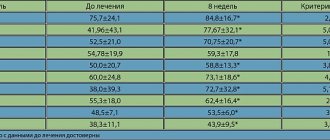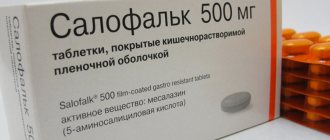Arava®
With hepatotoxic drugs and substances (including ethanol) or hematotoxic and immunosuppressive drugs
Increased adverse effects may occur when recent or concomitant use of hepatotoxic drugs and substances (including ethanol) or hematotoxic and immunosuppressive drugs is used, or when these drugs are started after treatment with leflunomide without a “Special Instructions” procedure.
With methotrexate
In some (5 out of 30) patients with rheumatoid arthritis, while taking leflunomide (10 - 20 mg per day) and methotrexate (10 - 25 mg per week), a 2-3-fold increase in the activity of liver enzymes in the blood was observed, and in the other 5 patients there was a more than 3-fold increase in the activity of “liver” enzymes in the blood. In all cases, these phenomena disappeared: in 2 patients while continuing to take both drugs, and in 3 patients after stopping taking leflunomide. Therefore, although there is generally no need for a waiting period when switching from leflunomide to methotrexate, careful monitoring of liver enzymes in the blood is recommended during the initial treatment phase after switching a patient from leflunomide to methotrexate.
Vaccination
There are no clinical data regarding the effectiveness and safety of vaccination administered during treatment with leflunomide. However, vaccination with live vaccines is not recommended. When planning vaccination with a live vaccine after discontinuation of leflunomide, its long half-life should be taken into account.
With warfarin
Cases of increased prothrombin time have been reported when taking leflunomide and warfarin simultaneously. In a clinical pharmacological study, a pharmacodynamic interaction between warfarin and A771726 was observed (see below). Therefore, when using warfarin and leflunomide simultaneously, careful monitoring of the INR (international normalized ratio) is recommended.
With food
The degree of absorption of leflunomide is not affected when it is taken together with food.
Effect of other drugs on leflunomide
In
vitro
studies conducted on human liver microsomes confirmed that the cytochrome P450 isoenzymes CYP1A2, CYP2C19 and CYP3A4 are involved in the metabolism of leflunomide.
in vivo
interaction study of leflunomide with cimetidine (a nonspecific weak inhibitor of cytochrome P450 isoenzymes) showed no significant effect of cimetidine on the systemic exposure of A771726. Following administration of a single dose of leflunomide to volunteers receiving multiple doses of rifampicin (a nonspecific cytochrome P450 inducer), maximum blood concentrations of A771726 increased by approximately 40%, whereas the area under the concentration-time curve (AUC) did not change significantly. The mechanism of this effect is not clear. The possibility of continued increases in leflunomide blood concentrations should be kept in mind in patients receiving multiple doses of leflunomide and rifampicin concomitantly. The use of cholestyramine or activated carbon leads to a rapid and significant decrease in the concentration of A771726 (the active metabolite of leflunomide) in the blood plasma. This is due to a violation of the enterohepatic recirculation of A771726 and/or its dialysis in the gastrointestinal tract (see sections “Pregnancy and breastfeeding” and section “Overdose”).
Effect of leflunomide on other drugs
Breast cancer resistance transport protein
( BCRP )
Although a pharmacokinetic interaction of A771726 with BCRP substrates (rosuvastatin) was observed (see below), no pharmacokinetic interaction was observed between leflunomide (10-20 mg daily) and methotrexate (a BCRP substrate; in 12 patients; 10 - 25 mg per week).
Drug interaction studies have demonstrated that there is no significant drug interaction between leflunomide and triphasic oral contraceptives. In a study in which leflunomide was administered to healthy female volunteers in conjunction with triphasic oral contraceptives containing 30 mcg ethinyl estradiol, no decrease in the contraceptive effect of the tablets was observed, and the pharmacokinetics of A771726 were well within their normal range. A pharmacokinetic interaction between contraceptives and A771726 has been observed (see below).
The following pharmacokinetic and pharmacodynamic interaction studies were conducted with A771726 (the main active metabolite of leflunomide). Since such drug interactions cannot be excluded for leflunomide when used at recommended doses, the following study results and recommendations should be taken into account in patients receiving leflunomide treatment.
Effect on repaglinide (
CYP 2 C
) After repeated doses of A771726, an increase in the mean maximum plasma concentration (Cmax) and AUC of repaglinide was observed (1.7 and 2.4 times, respectively), confirming that A771726 is an inhibitor of the CYP2C8 isoenzyme in
vivo .
Therefore, monitoring of patients concomitantly taking drugs metabolized by the CYP2C8 isoenzyme, such as repaglinide, paclitaxel, pioglitazone or rosiglitazone, is recommended, as this may increase their systemic exposure.
Effect on Caffeine (CYP1A2 Substrate
) Repeated doses
AUC of caffeine (CYP1A2 substrate) by 18% and 55%, respectively, suggesting that A771726 may be a weak inducer of CYP1A2 in
vivo .
Therefore, when combined with drugs metabolized by the CYP1A2 isoenzyme, such as duloxetine, alosetron, theophylline and tizanidine, caution should be exercised, as this may lead to a decrease in the effectiveness of these drugs.
Effect of organic anion transporter 3 (OAT3) on substrates
After repeated doses of A771726, an increase in the mean Cmax and AUC values of cefaclor was observed (1.43-fold and 1.54-fold, respectively), confirming that A771726 is an OAT3 inhibitor in
vivo .
Therefore, caution is recommended during concomitant use of OAT3 substrates, such as cefaclor, benzylpenicillin, ciprofloxacin, indomethacin, ketoprofen, furosemide, cimetidine, methotrexate, zidovudine.
Effect on
BCRP and/or organic anion transporting polypeptides B1 and B3 (OATP1B1/B3)
After repeated doses of A771726, an increase in the average Cmax and AUC values of rosuvastatin was observed (2.65 and 2.51 times, respectively). However, no significant effect of this increase in plasma exposure of rosuvastatin on HMG-CoA reductase activity was observed. When used concomitantly, the dose of rosuvastatin should not exceed 10 mg once daily. For other BCRP substrates (e.g., methotrexate, topotecan, sulfasalazine, daunorubicin, doxorubicin) and the organic anion transporter protein (OATP) family of substrates, especially HMG-CoA reductase inhibitors (e.g., simvastatin, atorvastatin, pravastatin, methotorexate, nateglinide, repaglinide, rifampicin) caution should also be exercised when using them together. Patients should be closely monitored for signs and symptoms indicating increased systemic exposure to these drugs, and a dose reduction of these drugs should be considered in such patients.
Effect on oral contraceptives (containing 0.03 mg ethinyl estradiol and 0.15 mg levonorgestrel)
After repeated doses of A771726, an increase in the mean values of Cmax AUC0.24 of ethinyl estradiol (1.58 and 1.54 times, respectively) and Cmax and AUC0-24 of levonorgestrel (1.33 and 1.41 times, respectively) was observed. However, this interaction is not expected to have an adverse effect on the effectiveness of oral contraceptives, and consideration of the type of oral contraceptive used is recommended.
Effect on warfarin
Repeated doses of A771726 have no effect on the pharmacokinetics of S-warfarin, indicating that A771726 is not an inhibitor or inducer of the CYP2C9 isoenzyme. However, with simultaneous use of A771726 and warfarin, a 25% decrease in maximum INR values was observed compared with those with warfarin alone. Therefore, when used concomitantly with warfarin, the INR should be carefully monitored.
Other interactions
If the patient is already taking non-steroidal anti-inflammatory drugs (NSAIDs and/or glucocorticosteroids), they can be continued after starting treatment with leflunomide.
There is currently no information regarding the combined use of leflunomide with antimalarial drugs used in rheumatology (for example, chloroquine and hydroxychloroquine), gold preparations (IM or orally), penicillamine, azathioprine and other immunosuppressants (with the exception of methotrexate, see above) . The risk associated with complex therapy, especially with long-term treatment, is unknown. Because this type of therapy can lead to the development of additive or even synergistic toxicities (for example, hepatotoxicity or blood toxicity), combinations of this drug with other basic drugs (for example, methotrexate) are undesirable. Recent concomitant or subsequent use of potentially myelotoxic agents may be associated with a greater risk of developing blood disorders.
Arava, 30 pcs., 20 mg, film-coated tablets
Arava should only be prescribed to patients after a thorough medical examination. Before starting treatment with Arava, it is necessary to remember the possible increase in the number of side effects in patients who have previously received other basic drugs for the treatment of rheumatoid arthritis, which have hepato- and hematotoxic effects. The active metabolite of leflunomide, A771726, has a long half-life, usually ranging from 1 to 4 weeks. Due to the long half-life of leflunomide's active metabolite, A771726, serious adverse effects (e.g., hepatotoxicity, hematoxicity, or allergic reactions, see below) may occur or persist even if leflunomide treatment is discontinued. In this case, a “washing” procedure should be carried out. The procedure can be repeated according to clinical indications. If severe immunological/allergic reactions such as Stevens-Johnson syndrome or Lyell's syndrome are suspected, a complete “washing” procedure is mandatory. Therefore, if such cases of toxicity occur or when switching to another basic drug (for example, methotrexate) after treatment with leflunomide, it is necessary to carry out a washout procedure (see below). Liver reactions Because the active metabolite of leflunomide, A771726, is protein bound and eliminated through hepatic metabolism and bile secretion, it is expected that plasma levels of A771726 may be increased in patients with hypoproteinemia. Arava is contraindicated in patients with severe hypoproteinemia or impaired liver function. (see section "Contraindications".). Rare cases of severe liver damage, in some cases fatal, have been reported during treatment with leflunomide. Most of these cases were observed during the first six months of treatment. Although the causal relationship of these adverse events to leflunomide has not been established, and in most cases there were several additional suspicious factors, strict adherence to treatment monitoring recommendations is considered mandatory. ALT levels should be checked before starting leflunomide therapy and then every 2 weeks for the first 6 months of treatment, followed by once every 6 to 8 weeks. There are the following recommendations for adjusting the dosage regimen or discontinuing the drug, depending on the severity and persistence of the increase in ALT levels. If ALT is confirmed to be 2-3 times the upper limit of normal, reducing the dose from 20 mg to 10 mg per day may allow leflunomide to be continued, provided that this indicator is carefully monitored. If 2-3 times the upper limit of normal ALT persists, or if there is a confirmed rise in ALT levels greater than 3 times the upper limit of normal, leflunomide should be discontinued and a washout procedure should be initiated. Due to possible additive hepatotoxic effects, it is recommended to avoid alcohol intake during treatment with leflunomide. Hematological reactions A complete clinical blood count, including determination of the leukocyte formula and platelet count, should be performed before starting treatment with leflunomide, as well as every 2 weeks during the first 6 months of treatment and then every 6-8 weeks. In patients with pre-existing anemia, leukopenia and/or thrombocytopenia, as well as in patients with impaired bone marrow function or at risk of developing such disorders, the risk of hematological disorders increases. If this type of phenomenon occurs, a “washing” procedure should be used to reduce the level of A771726 in the blood plasma. If serious hematological reactions, including pancytopenia, occur, discontinue Arava and any other concomitant drug that suppresses bone marrow hematopoiesis and initiate a washout procedure. Concomitant use with other treatments There is currently no information available regarding the concomitant use of leflunomide with antimalarial drugs used in rheumatology (for example, chloroquine and hydroxychloroquine), intramuscular or oral gold preparations, D-penicillamine, azathioprine and other immunosuppressive drugs (except methotrexate). The risk associated with the prescription of complex therapy, especially with long-term treatment, is unknown. Since this type of therapy can lead to the development of additive or even synergistic toxicity (for example, hepato- or hematotoxicity), combinations of this drug with other basic drugs (for example, methotrexate) are not advisable. Switching to other treatments Because leflunomide has a long shelf life in the body, switching to another disease-modifying drug (eg, methotrexate) without an appropriate washout may increase the potential for additional risks even long after switching (eg, kinetic interactions, organ toxicity). . Likewise, recent treatment with hepatotoxic or haematoxic drugs (eg methotrexate) may result in an increased incidence of adverse events, so when starting treatment with leflunomide, it is necessary to carefully consider all the positive and negative aspects associated with taking this drug. Skin reactions If ulcerative stomatitis develops, leflunomide should be discontinued. Very rare cases of Stevens-Johnson syndrome or toxic epidermal necrolysis have been reported in patients receiving leflunomide. If skin and/or mucosal reactions occur, you should stop taking Arava and any other related drug and immediately begin a washout procedure. It is necessary to achieve complete elimination of the drug from the body. In such cases, re-prescribing the drug is contraindicated. Infections It is known that drugs like leflunomide, which have immunosuppressive properties, make patients more susceptible to various types of infections, including opportunistic infections (infections caused by fungi and microorganisms that can cause infections only in conditions of decreased immunity). Infectious diseases that arise are usually severe and require early and intensive treatment. If a severe infection occurs, it may be necessary to interrupt leflunomide treatment and initiate a washout procedure. Tuberculin-positive patients should be closely monitored due to the risk of reactivation of tuberculosis. Respiratory tract reactions Rare cases of interstitial pulmonary disease have been reported during leflunomide therapy. Symptoms such as cough and dyspnea may be a reason to stop taking leflunomide. Blood pressure Blood pressure levels should be monitored before starting treatment with leflunomide and periodically after starting it. Interactions Caution should be exercised when prescribing drugs metabolized by CYP2C9 (phenytoin, warfarin, tolbutamide), with the exception of NSAIDs (non-steroidal anti-inflammatory drugs). Recommendations for men There is no data on the risk of fetotoxicity (associated with the toxic effect of the drug on the father's sperm) when using leflunomide in men. Experimental data in this direction have not been carried out. To minimize the possible risk, men planning to have a child should stop taking leflunomide and use cholestyramine 8 g 3 times a day for 11 days or 50 g of powdered activated carbon 4 times a day for 11 days.




